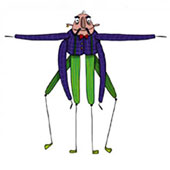With rough animation in hand, it was time to draw in the final strokes. This stage involves tracing the rough animation with clean and solid lines, capturing all the details of the characters and fixing any errors in proportions. Consistency of the character’s movements was key and was achieved by referring to the character model sheet created in pre-production. Clean-up animation was carried out on a new layer. This is equivalent to drawing on tracing paper over 30 existing pieces of work (rough animation). These are the final drawings that will appear in the film. All frames were drawn in black. A few important aspects to keep in mind in this stage were:
- Every animated object was cleaned up on a different layer. This allowed easy manoeuvring and editing of different objects without affecting others.
- A charcoal brush was used to allow the lines to look more hand-drawn.
- Pressure applied to create the strokes had to be kept in mind to ensure that lines looked consistent.
- Size of the brush varies depending on the nature of the shot and the distance from the camera. Objects far away from the camera are made up of thinner strokes while in close-up shots, the lines appear thicker.
- Aim to close all stroke paths to assist ease in the colour stage.
- If an object or a part of the object did not move, then strokes from the previous frame had to be duplicated and NOT redrawn otherwise the lines appear to move or jerk.
- Actions were divided into foreground actions, middle ground actions and background actions. These had to exist on different layers.
- Clean-up tends to take longer to complete than rough animation as the animator has to keep in mind the precision and details of the character and props.



